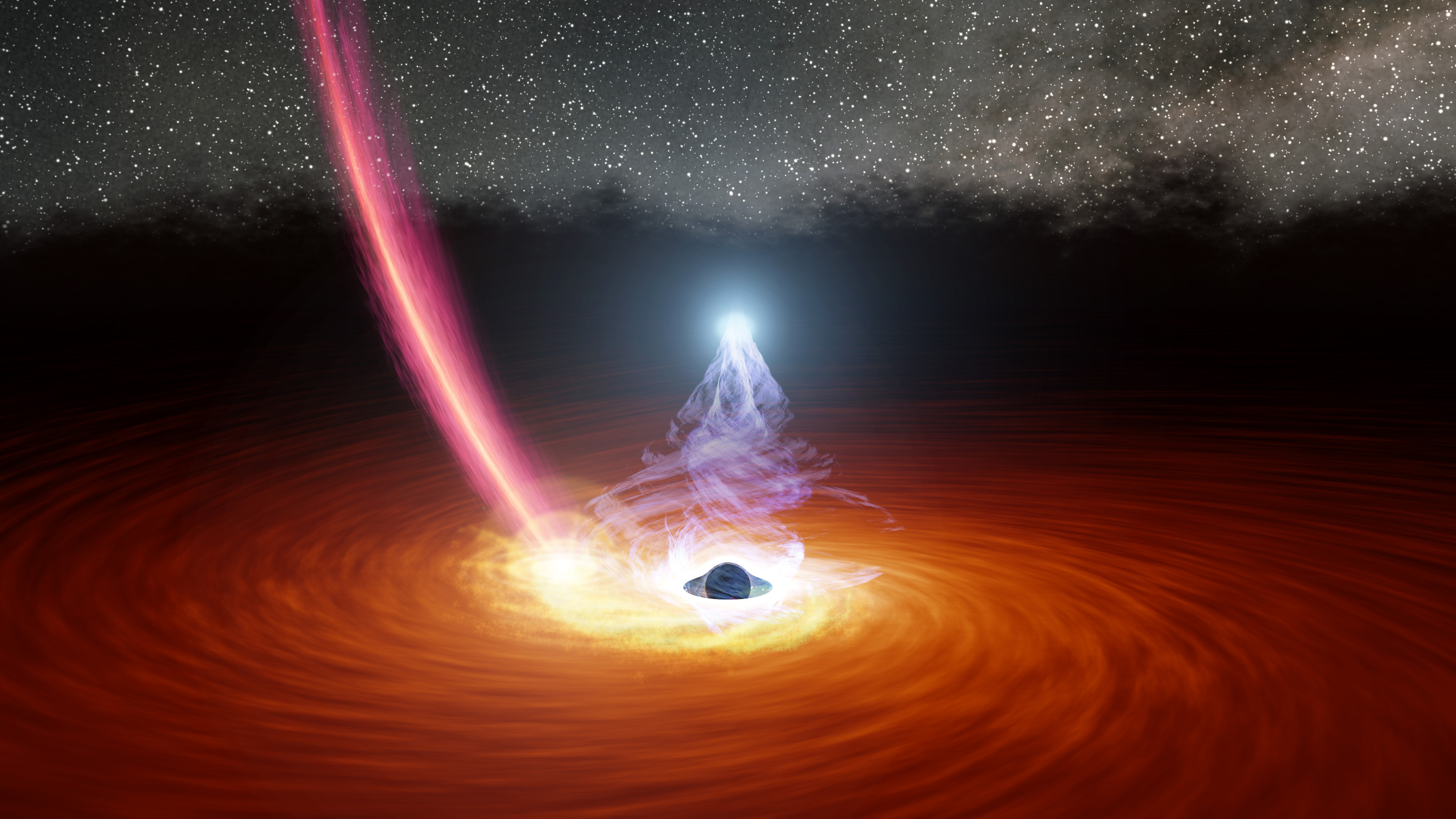Astronomers have spotted x-rays from behind a supermassive black hole
The discovery might help scientists better understand why black holes are such powerful objects.

When gas falls into a black hole, it releases an enormous amount of energy and spews electromagnetic radiation in all directions, making these objects some of the brightest in the known universe. But scientists have only ever been able to see light and other radiation from a supermassive black hole when it’s shining directly toward our telescopes—anything from behind it has always been obscured.
Until now. A new study published in Nature demonstrates the first detection of radiation coming from behind a black hole—bent as a result of the warping of spacetime around the object. It’s another piece of evidence for Einstein’s theory of general relativity.
"This is a really exciting result," says Edward Cackett, an astronomer at Wayne State University who was not involved with the study. "Although we have seen the signature of x-ray echoes before, until now it has not been possible to separate out the echo that comes from behind the black hole and gets bent around into our line of sight. It will allow for better mapping of how things fall into black holes and how black holes bend the space time around them."
The release of energy by black holes, sometimes in the form of x-rays, is an absurdly extreme process. And because supermassive black holes release so much energy, they are essentially powerhouses that allow galaxies to grow around them. “If you want to understand how galaxies form, you really need to understand these processes outside the black hole that are able to release these enormous amounts of energy and power, these amazingly bright light sources that we’re studying,” says Dan Wilkins, an astrophysicist at Stanford University and the lead author of the study.
The study focuses on a supermassive black hole at the center of a galaxy called I Zwicky 1 (I Zw 1 for short), around 100 million light-years from Earth. In supermassive black holes like I Zw 1's, large amounts of gas fall toward the center (the event horizon, which is basically the point of no return) and tend to flatten out into a disk. Above the black hole, a confluence of supercharged particles and magnetic field activity results in the production of high-energy x-rays.
Some of these x-rays are shining straight at us, and we can observe them normally, using telescopes. But some of them also shine down toward the flat disk of gas and will reflect off it. I Zw 1 black hole’s rotation is slowing down at a higher rate than that seen in most supermassive black holes, which causes surrounding gas and dust to fall in more easily and feed the black hole from multiple directions. This, in turn, leads to greater x-ray emissions, which is why Wilkins and his team were especially interested.
While Wilkins and his team were observing this black hole, they noticed that the corona appeared to be “flashing.” These flashes, caused by x-ray pulses reflecting off the massive disk of gas, were coming from behind the black hole’s shadow—a place that is normally hidden from view. But because the black hole bends the space around it, the x-ray reflections are also bent around it, which means we can spot them.
The signals were found using two different space-based telescopes optimized to detect x-rays in space: NuSTAR, which is run by NASA, and XMM-Newton, which is run by the European Space Agency.
The biggest implication of the new findings is that they confirm what Albert Einstein predicted as part of his theory of general relativity—the way light ought to bend around gargantuan objects like supermassive black holes.
“It’s the first time we really see the direct signature of the way light bends all the way behind the black hole into our line of sight, because of the way black hole warps space around itself,” says Wilkins.
"While this observation doesn't change our general picture of black hole accretion, it is a nice confirmation that general relativity is at play in these systems," says Erin Kara, an astrophysicist at MIT who was not involved with the study.
Despite the name, supermassive black holes are so far away that they really just look like single points of light, even with state-of-the-art instruments. It’s not going to be possible to take images of all of them the way scientists used the Event Horizon Telescope to capture the shadow of a supermassive black hole in galaxy M87.
So although it’s early, Wilkins and his team are hopeful that detecting and studying more of these x-ray echoes from behind the bend could help us create partial or even full pictures of distant supermassive black holes. In turn, that could help them unlock some big mysteries around how supermassive black holes grow, sustain entire galaxies, and create environments where the laws of physics are pushed to the limit.
Correction 8/3/21: The initial version of this story incorrectly stated that Einstein made his prediction in 1963. We regret the error.
Deep Dive
Space
How to safely watch and photograph the total solar eclipse
The solar eclipse this Monday, April 8, will be visible to millions. Here’s how to make the most of your experience.
The great commercial takeover of low Earth orbit
Axiom Space and other companies are betting they can build private structures to replace the International Space Station.
How scientists are using quantum squeezing to push the limits of their sensors
Fuzziness may rule the quantum realm, but it can be manipulated to our advantage.
Stay connected
Get the latest updates from
MIT Technology Review
Discover special offers, top stories, upcoming events, and more.